T
Thomas Geiger
Guest
Smart is one of the most daring car brands to have been launched in the past 50 years, but it has be considered a billion-euro failure. That could change with the switch from pure Daimler ownership to a joint venture with Chinese giant Geely – and now we’ve had an exclusive preview of the car that will kick-start the revival.
The concept seen here – previewed by our exclusive image, based on an official design sketch – will make its debut at this autumn’s Munich Motor Show and go into production in a barely changed form by the end of 2023. It’s based on Chinese technology, but uses styling cues developed by Smart’s own in-house team, led by Mercedes design chief Gorden Wagener.
The most obvious switch with the as-yet-unnamed model is that it grows in size compared with Smart’s current offerings. Instead of the tiny city car for which Smart is known, the brand’s rebirth will be based on a vehicle that sits somewhere between a supermini and a family hatchback. It should be comfortably north of four metres long, in fact – potentially as big as a MINI Countryman, an obvious rival. Inside, there should be seating for five adults.
The car’s looks will continue the break from tradition, because they have little in common with the ForTwo and ForFour; even the logo has been heavily retouched. The trademark visible safety cell has been axed, along with the ForTwo’s cheeky grin and some of the plastic panels. “We have taken the opportunity to reinvent the brand,” Wagner told us, before suggesting that the new Smart face is supposed to be “cool, sexy and grown-up instead of cute and playful”. There are some carry-overs in the SUV, though, such as a two-tone paint job with a contrast roof that seems to ‘float’ above the cabin like the peak of a baseball cap.
Inside, expect an infotainment system that’s at least as colourful and feature-packed as Mercedes’ own MBUX set-up.
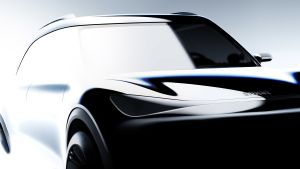
Smart SUV - teaser
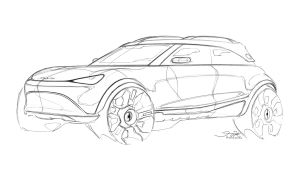
Smart SUV - sketch
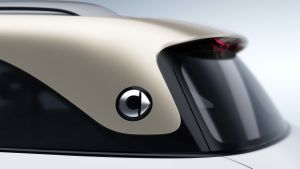
Smart SUV - rear teaser
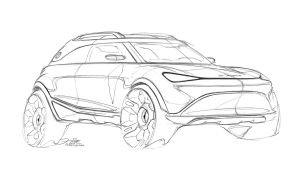
Smart SUV - sketch 2

Smart SUV - front (watermarked)
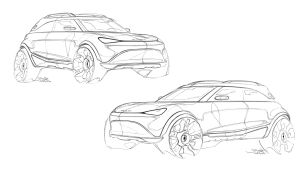
Smart SUV - sketches
The new Smart will be one of the first cars to be based on Geely’s Sustainable Experience Architecture (SEA), a common platform that will underpin everything from the brand’s own Chinese-market models, like the recently launched Zeekr brand, to new Lynk & Co vehicles and Volvo’s forthcoming all-electric baby SUV.
SEA can support single, dual and triple-motor configurations, and accommodate enough battery cells to offer more than 430 miles of range under China’s less-stringent NEDC efficiency test.
The Smart won’t get that sort of capacity, which is probably reserved for larger SEA models. But it’s perfectly possible that it could offer more than 200 miles between charges, which is more than double the range of the current EQ ForTwo. And SEA supports 800V technology, so it is conceivable that the new Smart could offer super-fast charging speeds that trump those of Mercedes’ own models.
The choice of the SEA platform should give the Smart impressive packaging, too. “Just like the current Smart models, the first car of the new era will also offer a better ratio of length to interior space than conventional vehicles,” Wagener said.
The more premium materials, bigger battery and growth in body size are all but certain to bring a rise in price. But the SUV should still be pitched beneath Mercedes stalwarts like the A-Class and EQA, not least because it will be manufactured in China, with lower overheads. “We will remain an accessible brand for our customers,” promised Smart boss Daniel Lescow.
Do you think the Smart SUV will be a success? Let us know your thoughts in the comments section...
Continue reading...
The concept seen here – previewed by our exclusive image, based on an official design sketch – will make its debut at this autumn’s Munich Motor Show and go into production in a barely changed form by the end of 2023. It’s based on Chinese technology, but uses styling cues developed by Smart’s own in-house team, led by Mercedes design chief Gorden Wagener.
- SEE MORE Best electric SUVs to buy now
The most obvious switch with the as-yet-unnamed model is that it grows in size compared with Smart’s current offerings. Instead of the tiny city car for which Smart is known, the brand’s rebirth will be based on a vehicle that sits somewhere between a supermini and a family hatchback. It should be comfortably north of four metres long, in fact – potentially as big as a MINI Countryman, an obvious rival. Inside, there should be seating for five adults.
The car’s looks will continue the break from tradition, because they have little in common with the ForTwo and ForFour; even the logo has been heavily retouched. The trademark visible safety cell has been axed, along with the ForTwo’s cheeky grin and some of the plastic panels. “We have taken the opportunity to reinvent the brand,” Wagner told us, before suggesting that the new Smart face is supposed to be “cool, sexy and grown-up instead of cute and playful”. There are some carry-overs in the SUV, though, such as a two-tone paint job with a contrast roof that seems to ‘float’ above the cabin like the peak of a baseball cap.
Inside, expect an infotainment system that’s at least as colourful and feature-packed as Mercedes’ own MBUX set-up.

Smart SUV - teaser

Smart SUV - sketch

Smart SUV - rear teaser

Smart SUV - sketch 2

Smart SUV - front (watermarked)

Smart SUV - sketches
The new Smart will be one of the first cars to be based on Geely’s Sustainable Experience Architecture (SEA), a common platform that will underpin everything from the brand’s own Chinese-market models, like the recently launched Zeekr brand, to new Lynk & Co vehicles and Volvo’s forthcoming all-electric baby SUV.
SEA can support single, dual and triple-motor configurations, and accommodate enough battery cells to offer more than 430 miles of range under China’s less-stringent NEDC efficiency test.
The Smart won’t get that sort of capacity, which is probably reserved for larger SEA models. But it’s perfectly possible that it could offer more than 200 miles between charges, which is more than double the range of the current EQ ForTwo. And SEA supports 800V technology, so it is conceivable that the new Smart could offer super-fast charging speeds that trump those of Mercedes’ own models.
The choice of the SEA platform should give the Smart impressive packaging, too. “Just like the current Smart models, the first car of the new era will also offer a better ratio of length to interior space than conventional vehicles,” Wagener said.
The more premium materials, bigger battery and growth in body size are all but certain to bring a rise in price. But the SUV should still be pitched beneath Mercedes stalwarts like the A-Class and EQA, not least because it will be manufactured in China, with lower overheads. “We will remain an accessible brand for our customers,” promised Smart boss Daniel Lescow.
Do you think the Smart SUV will be a success? Let us know your thoughts in the comments section...
Continue reading...
